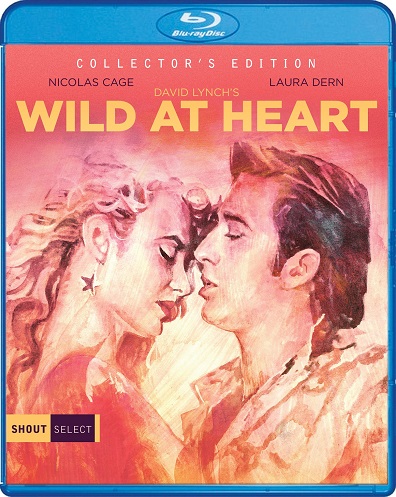
Wild at Heart [Collector’s Edition]
Studio: Shout! Factory
Aug 29, 2018
Web Exclusive
![]()
There’s a scene in Wild at Heart where its two central, star-crossed lovebirds – Nic Cage’s Elvis-obsessed Sailor Ripley and Laura Dern’s free-spirited Lula Fortune – come across a grisly car accident. They pull over to investigate, finding two passengers deceased – and another, played by Twin Peaks’ Sherilyn Fenn, stumbling through the darkness, bleeding from the head and obviously dying. The girl is given no name, and her only lines are trivial, confused rants; she begs Sailor and Lula not to tell her mother what happened, and to help her find her purse and hairbrush as they try in vain to escort her into their vehicle. She stumbles head-first, coughs up a fearful volume of syrupy blood, and dies. Lula breaks down, and tearfully wonders out loud why the girl had to go and die in front of them.
This scene – much like the child killed by a speeding truck in one of the most unshakeable sequences of last year’s Twin Peaks: The Return – has little bearing on the movie’s plot; indeed, it was one written in by Lynch and not part of the original Barry Gifford novel which inspired the film. Rather, it marks a clear line of delineation between the positive, love-conquers-all tone of the movie’s onset and the circling descent into hell that it becomes in its final act. The last time we see those two before this scene, they’re making out alongside the road against a Texas sunset – this would have been any other movie’s happy ending. Instead it’s all far, far downhill from there.
It’s a sort of scene that stands out as a rare in Lynch’s oeuvre. Normally, the filmmaker would approach such darkness with a wink or a smile. (See: a dog wandering off with a severed hand in its mouth after Wild at Heart’s botched robbery; Willem Dafoe’s sick punchline at the end of the film’s infamous rape scene.) But there’s nothing funny about Fenn’s rambling death alongside a dark Texas road, consumed by trivialities and tragically unaware of what’s happening to her. For a director so famous for his surreal flourishes, it’s this moment of stark realism that may be the movie’s most surreal-feeling. That says a lot about a film which features two musical numbers, a voodoo-practitioner hitwoman, and a surprise fairy godmother who descends from the heavens to bless the movie with an unexpected happy ending.
Wild at Heart is only very loosely plot-driven, even taking into consideration the filmmaker whose work we’re discussing. Lula Fortune is the rebellious, 20-year-old daughter of a family with some sort of mob ties. Sailor Ripley wears a snakeskin jacket that’s an often-stated symbol of his individuality and belief in personal freedom; years ago he chauffeured for a dangerous gangster. What’s important is that Sailor and Lula are madly in love. This is no good for her mother, Marietta (Dern’s real-life mother, Diane Ladd, in an Oscar-nominated performance), who believes Sailor witnessed the murder of her husband, in which she had a hand. She’s out to break up the young couple, even if that means sending after them a private detective (Harry Dean Stanton) and several hitmen.
Lynch saw Sailor and Lula as two pure souls, and viewed Gifford’s novel as a love story set in hell. Wild at Heart is a road movie tracking the couple’s flight from Carolina en route to the West Coast and all of the shit that goes wrong around them along the way. The individual scenes may barely connect but not a single one is forgettable. Wild at Heart plays as an excuse for Lynch to explore some of the darkest corners of his sensibilities, at the same time filming a pseudo-musical comedy pastiche of The Wizard of Oz and Elvis Presley films. It’s very weird, even by Lynch’s standards – which makes it an essential Lynch movie.
And oh, what a cast this film has. (When Nicolas Cage is far from the strangest character in a film, you know that you’re taking an extra-special ride.) Willem Dafoe plays Bobby Peru, a villain so gross and perverse that he makes Blue Velvet’s Frank Booth look like a proper, buttoned-down gentleman. Crispin Glover makes a small-but-extremely memorable appearance as Dell, Lula’s disturbed cousin who believes aliens are controlling the weather and keeps live cockroaches in his underwear. The irreplaceable Harry Dean Stanton plays Johnnie Farragut, a gumshoe hopelessly in love with Ladd’s Marietta; John Lurie pops in as a drunken goon. You’ll also find several of Lynch’s repertory actors, including Isabella Rossellini, Frances Bay, Freddie Jones, and Jack Nance. (In addition to Nance and Fenn, Grace Zabriskie, Sheryl Lee, and David Patrick Kelly all made their way over from Twin Peaks, which had just wrapped its pilot when Lynch took on Wild at Heart.)
Shout! Factory have done a service in bringing Wild at Heart to Blu-ray. It’s presumably mastered from the same improved print Lynch produced for the old Special Edition DVD release but is served very well by the upgrade to high definition. The extra features are a real highlight, and are quite plentiful – including almost 80 minutes of deleted scenes and a lengthy Making Of featurette. While most big Lynch fans will have seen these before, it’s nice to have them all carried over to the upgraded edition. There’s one new bonus feature: a 30-minute interview with novelist Barry Gifford, who is pretty accepting of the wholesale changes Lynch made to his characters and story. All in all, this edition makes it well worth moving on from any older copies of the movie you’ve been holding onto.
(www.shoutfactory.com/product/wild-at-heart-collector-s-edition)
Current Issue

Issue #72
Apr 19, 2024 Issue #72 - The ‘90s Issue with The Cardigans and Thurston Moore

Comments
Submit your comment
There are no comments for this entry yet.